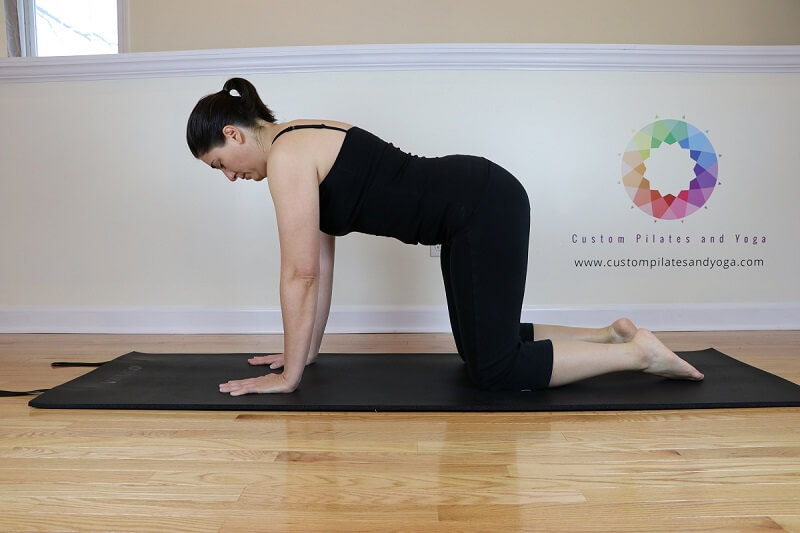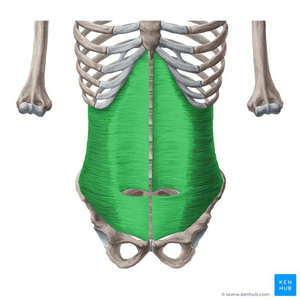Top 2 Weak Transverse Abdominis Symptoms (and 3 Easy Exercises to Fix It)
If you’re searching for weak transverse abdominis symptoms, your back probably hurts. Do you know why I guessed that? Because back pain is the #1 symptom of a weak transverse abdominis. Here’s more about weak TA muscles and three easy exercises to fix them.

When you ask people about their abdominals, they mainly think about one abdominal muscle. You know the one. It gives people those beautiful six-pack abs that all the popular models have. It’s called the rectus abdominis.
But, what most people don’t know is that this muscle isn’t the key to your core strength. Instead, it’s a much deeper abdominal muscle called the transverse abdominis that is crucial if you’re going to have strength.
If you’re part of the group that’s wondering, Transversa what?, don’t worry. This post is going to teach you everything you need to know about the transverse abdominis, also known as the TA.
Here’s more about what the transverse abdominis does, how to find it, and how to tell if it’s weak. Then, you’ll learn three easy strengthening exercises. This way, even if you discover what you’re going through isn’t part of the weak transverse abdominis symptoms, you’ll know some easy exercises you can do to keep it strong.
Related: If you’ve got back pain, strengthening your transverse abdominis is just one part of the equation for kissing your pain goodbye. You can learn the second (and most important part) of the recipe for pain relief for free right here.
What is the transverse abdominis?
Sure, the transverse abdominis is a muscle. But, it isn’t just any muscle. The transverse abdominis works a little differently from other muscles because it’s a muscle that’s supposed to work involuntarily.
That’s right. Without even thinking about it, your transverse abdominis is supposed to be working–correctly. This is because its primary task is to help with respiration. Specifically, it’s supposed to help you exhale fully.
Think of it this way: If the rectus abdominis is like Marcia Brady (because it’s so pretty and popular), the transverse abdominis is like a temporary replacement for Bradys’ housekeeper, Alice. If you’re a Brady Bunch fan, you already know that Alice totally runs the show in the Brady house. She knows what everyone wants and needs, anticipates it, and then provides it without being asked. This is exactly how your transverse abdominis is supposed to work.
But, what happens if someone who isn’t Alice has to step into the Brady world and run the show? They’d have no idea what to do; they wouldn’t be able to anticipate the Bradys’ needs. My gosh, someone might actually have to ask for a snack! And what would happen if the trash didn’t go out on trash day?!
Anyway, your transverse abdominis is supposed to work like Alice–doing its tasks, helping nearby muscles, etc. However, sometimes that transverse abdominis gets weak and ends up acting like some weak imitation version of itself. It quits contracting like it’s supposed to and, next thing you know, you’ve got horrible back pain.
But, is this muscle the one that’s causing your back pain? Keep reading to learn a little bit more about where your transverse abdominis is.
Where is the transverse abdominis?
Every muscle has an origin (starting point) and insertion (ending point).
Medically speaking, the transverse abdominis originates on the “lateral one-third of the inguinal ligament, anterior two-thirds of inner lip of the iliac crest, thoracolumbar fascia and from the inner edges of the lower 6 costal cartilages.”
It inserts on “the linea alba by its aponeurosis.”
In plain English: Your transverse abdominis runs from the sides of your vertebrae in your low back, filling the space between the bottom of your rib cage and the top of your pelvis. It wraps around to a thing called your linea alba, which is that line that divides you right down the middle of your abdomen to give you six-pack abs.
What exactly does the transverse abdominis do?
The transverse abdominis, also known as the transversus or TA, bridges the gap between your ribs and pelvis. This deep muscle helps support the ribs, pelvis, and vertebrae while serving as an anchor for your other abdominal muscles.
Because of its connection to the ribs, pelvis, and vertebrae; the transverse abdominis is one of many muscles determining whether or not you have back pain.
Many people think of the transverse abdominis muscle as the body’s natural corset. I, however, think of it as more like a sausage casing for three reasons:
- It keeps all the good stuff (your organs) inside.
- Like sausage casings, this thin muscle can rip or develop holes. When this happens, your internal organs can start to spill out through an umbilical hernia.
- I would much rather think about eating sausages than think about stuffing myself into a corset.
In addition to helping to keep your internal organs inside you and keep the right amount of space between your ribs and hips, the transverse abdominis is an important muscle for breathing.
In fact, breathing is the main form of transverse abdominis activation. This means it’s the main way to work this crucial muscle.
But, we all breathe—all the time. So, how can my transverse abdominis be weak? And how would I even know if it was?
Keep reading, friend. I promise it will all make sense soon.
What else does the transversus do?
We’ve already talked a little bit about what the transversus does. We know it:
- connects your ribs, pelvis, and vertebrae;
- keeps all your internal organs inside you; and
- helps you breathe.
It also serves as a stabilizing structure for your other abdominal muscles. Muscles such as the internal obliques and external obliques (which lay directly on top of the transversus) can work correctly because of the stability from the transverse abdominis.
I’m so glad you asked.
So, as you can see, the TA’s job is to be an anchor point and hold the whole core area of your body together. That’s a lofty job!
And yet, how in the world would you know if your ribs weren’t connected to your pelvis correctly or if your organs weren’t being properly contained?
How to Tell If You Have a Weak Transverse Abdominis
To tell if you have a weak transverse abdominis, do this quick test:
- Take a seat. It doesn’t have to be anywhere fancy. Sitting on your kitchen stool will be just fine.
- Place your hands on the bottom of your rib cage. Make sure your fingers face forward and your thumbs go around toward your back.
- Slide your hands up and down a little way. This helps you get a feel for how your rib cage is angled.
- Does your rib cage point 100% straight down to your pelvis? Chances are, you’re pretty close but your rib cage might be angled a little forward. If you imagine a line down from your rib cage and keep sliding your hands, you might end up high up on your thighs. This is, as my mom likes to say, “Close, but no cigar.” You have a weak TA, friend.
- If your hands slide straight down from the bottom of your rib cage to the top of your hips, your transversus is doing just fine. Unfortunately, any other angles that result in your ribs and pelvis not matching up exactly mean you have some degree of weakness.
Top 2 Weak Transverse Abdominis Symptoms
When the transverse abdominis is weak or dysfunctional, it doesn’t correctly hold your organs inside your body cavity or support your other abdominal muscles. This dysfunction has a two-fold effect.
- A weak transversus can tug on the lumbar spine (low back) and cause back pain.
- When your internal organs spill out of your body, you look poochy and doughy.
Okay, it’s true that one of those seems more serious than the other, and having a weak transverse abdominis can hurt your low back and your ego. Luckily, it’s a really easy muscle to strengthen.
3 Easy Exercises to Strengthen the Transverse Abdominis
Let’s think about what we know about the transverse abdominis:
- It connects your ribs, spine, and pelvis.
- It’s used in breathing.
- If your pelvis or ribs are angled (even slightly) away from each other when you’re sitting, standing, or lying down; it means your TA is weak.
This means the very best strengthening exercises are the ones where you’ve got your rib-to-hip connection absolutely perfect. Then, you’ll move your arms or legs or change your position to challenge your TA’s ability to hold the connection.
Let’s start strengthening!
1. Pilates breathing
Since we already know the transverse abdominis is activated by breathing, it’s no surprise that breathing is the very best way to engage this important muscle. In my opinion, Pilates breathing is the best way to strengthen this deep muscle.
It’s incredibly important for you to pay attention to what you are doing as you breathe. Notice the muscles you’re using and make sure you don’t feel any pain in the bottom of your pelvis. If you do feel pain, you need to stop immediately.

- Sit comfortably next to a wall. Feel yourself connect down to the floor beneath you. Sit up tall.
- Make sure to relax the front of your hips. Let your shoulder blades sit on the back of your rib cage like a superhero cape resting on your back.
- Inhale through your nose and feel your rib cage expand to the front, sides, and back.
- Make sure your rib cage didn’t open forward like it’s spilling out your internal organs. (Not sure what the heck I just said? Check out this post about rib cage placement.)
- Exhale through pursed lips (like you’re blowing out candles) and feel your muscles between your ribs and hips evenly draw toward the center of your abdomen.
- Inhale and exhale, feeling how your muscles move away from and toward a central point in the middle of your abdomen.
Pro Tip: Feel your waist constrict as you exhale, and you’re doing it right!
2. Dying bug
Dying bug is one of my absolute favorite Pilates exercises. This is because there are so many variables that you can use to make this exercise as hard or as easy as you’d like. The version below is the very easiest version. Don’t be fooled, though—it’s still really effective.

- Come onto your back. Have your knees bent and your heels about a fist’s distance apart.
- Make sure your rib cage is perfectly aligned so it’s pointing right down to your pelvis. If your ribs are slightly angled up, give yourself a little scratch between your bottom ribs, and the muscle you need should kick in and tuck your ribs. Keep your excellent rib-to-hip connection throughout the entire exercise.
- Reach both arms straight toward the ceiling with your palms facing each other.
- Warning: You’re going to do two things at once and your brain is going to have to work.
- Inhale through your nose and hinge your right arm so it moves in a straight line toward the ground as your left leg slides out straight.
- Exhale through pursed lips and bring your right arm and left leg back to center.
- Inhale through your nose and hinge your left arm so it moves in a straight line toward the ground as your right leg slides out straight.
- Exhale through pursed lips and bring your left arm and right leg back to center.
- This makes one set. Complete about 10 sets.
Pro Tip: Make sure you keep your rib-to-hip connection nice and strong throughout the entire exercise.
3. Table top pose
In yoga, Table top pose really gets overlooked. It’s often a transition to move up to Downward facing dog, or it’s the pose that gets you set up for Cat pose. However, when you take the time to strengthen your rib-to-hip connection in this position, you’re doing a ton of transverse abdominis strengthening.

- Begin on your hands and knees with your hands under your shoulders and your knees under your hips.
- Spread your fingers like starfish, and press the floor away. You’ll notice that, as you do this, the eyes of your elbows rotate toward the front of the mat. If the insides of your elbows are facing each other or your thighs, you need to think about opening across the front of your chest and press the floor away.
- Bring your pelvis to a neutral position. When you do this, your SITs bones should be pointing to the wall behind you. (So, it’s going to feel like you’re sticking your butt out at whichever wall is behind you.) Feel the length through your spine from your SITs bones through the top of your head. Slightly tuck your chin so your head is in neutral.
- Once your pelvis is in neutral, think of hugging your belly toward that spot you found right in the center of your abdomen. (Remember? You did this in Pilates breathing.) Make sure you don’t move your spine.
- Press the tops of your feet into your mat.
- Once you’ve got everything set to the best of your ability, breathe in through your nose. Exhale through pursed lips like you’re blowing out candles.
- Hold here for several rounds of breath.
Pro Tip: If you have a mirror available to check your form while you do this, I highly recommend using it. This is one of those deceptively-simple exercises. It seems easy enough when you read the directions, but holding the correct position can be very challenging.
Frequently Asked Questions About Weak Transverse Abdominis Symptoms
Even though you’ve already learned so much about the transverse abdominis muscle (like how to tell if it’s weak and how to make it strong), you might still have some more questions. These are some of the most common questions I’m asked about weak transverse abdominis symptoms.
1. What happens if transverse abdominis is weak?
If your transverse abdominis is weak, it can lead to back pain. Your transverse abdominis muscle is primarily used when you forcefully exhale. Otherwise, it’s a really important stabilizing muscle that other muscles rely on to work correctly. So, when it doesn’t do its job, other muscles tug and pull on bones like your pelvis and spine. This leads to back pain–especially lower back pain.
2. How do you fix a weak transverse abdominis?
In my opinion, the three very best exercises to do to fix a weak transverse abdominis are:
- Pilates breathing.
- Dying bug.
- The Table Top yoga pose.
There are other exercises that deserve honorable mentions such as Leg slides and Toe taps. But honestly, almost every exercise in Pilates and yoga will help you fix your weak transverse abdominis as long as you mindfully practice your breathing while you do the exercise.
3. How do you test transverse abdominis strength?
To test transverse abdominis strength:
- Take a seat. It doesn’t have to be anywhere fancy. Sitting on your kitchen stool will be just fine.
- Place your hands on the bottom of your rib cage. Make sure your fingers face forward and your thumbs go around toward your back.
- Slide your hands up and down a little way. This helps you feel how your rib cage is angled.
- Does your rib cage point 100% straight down to your pelvis? Chances are, you’re pretty close but your rib cage might be angled a little forward. If you imagine a line down from your rib cage and keep sliding your hands, you might end up high up on your thighs. This is, as my mom likes to say, “Close, but no cigar.” You have a weak TA, friend.
- If your hands slide straight down from the bottom of your rib cage to the top of your hips, your transversus is doing just fine. Unfortunately, any other angles that result in your ribs and pelvis not matching up exactly mean you have some degree of weakness.
Once your rib cage is angled down at your pelvis, challenge yourself to raise an arm straight above your head. Lower your arm, and check your rib cage placement. If your rib cage moved out of place, your transverse abdominis is weak right now.
If you held your rib-to-hip connection, good job! Give yourself a harder test by doing the exercise Leg slides.
4. Can you tighten transverse abdominis?
Great news–you can absolutely strengthen your transverse abdominis! Those three exercises you learned earlier are a great starting point. Then, when you feel like you’ve mastered those, you should check out some other Pilates exercises like Hip lift, One leg circle, and Spine twist.
But, if you’re serious about avoiding back injury and strengthening your weak transverse abdominis, I highly recommend my course, Spinal Rejuvenation.
Want to learn more ways to strengthen your transverse abdominis?
The three exercises you learned earlier are a great place to start if you’re serious about strengthening your transverse abdominis. If you’re searching for more ways to get stronger, check out my online course, Spinal Rejuvenation. You’ll learn how to strengthen the transversus, as well as other muscles that cause or contribute to low back pain.
Or, if you want a free taste of what you’ll learn in Spinal Rejuvenation, click here to download The Fast + Easy Way to Relieve Hip + Back Pain.
Thank you to Kenhub.com, a leader in online anatomy, for the use of their transverse abdominis image.


Very useful text. Thank you!
Thank you, Anna!